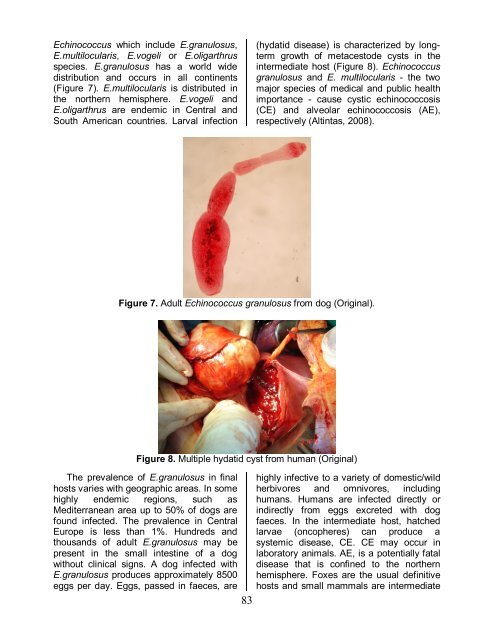ÐÑой 4/2010 - СÑопанÑки ÑакÑлÑÐµÑ - Югозападен ÑнивеÑÑиÑеÑ
ÐÑой 4/2010 - СÑопанÑки ÑакÑлÑÐµÑ - Югозападен ÑнивеÑÑиÑеÑ
ÐÑой 4/2010 - СÑопанÑки ÑакÑлÑÐµÑ - Югозападен ÑнивеÑÑиÑеÑ
Create successful ePaper yourself
Turn your PDF publications into a flip-book with our unique Google optimized e-Paper software.
Echinococcus which include E.granulosus,<br />
E.multilocularis, E.vogeli or E.oligarthrus<br />
species. E.granulosus has a world wide<br />
distribution and occurs in all continents<br />
(Figure 7). E.multilocularis is distributed in<br />
the northern hemisphere. E.vogeli and<br />
E.oligarthrus are endemic in Central and<br />
South American countries. Larval infection<br />
(hydatid disease) is characterized by longterm<br />
growth of metacestode cysts in the<br />
intermediate host (Figure 8). Echinococcus<br />
granulosus and E. multilocularis - the two<br />
major species of medical and public health<br />
importance - cause cystic echinococcosis<br />
(CE) and alveolar echinococcosis (AE),<br />
respectively (Altintas, 2008).<br />
Figure 7. Adult Echinococcus granulosus from dog (Original).<br />
Figure 8. Multiple hydatid cyst from human (Original)<br />
The prevalence of E.granulosus in final<br />
hosts varies with geographic areas. In some<br />
highly endemic regions, such as<br />
Mediterranean area up to 50% of dogs are<br />
found infected. The prevalence in Central<br />
Europe is less than 1%. Hundreds and<br />
thousands of adult E.granulosus may be<br />
present in the small intestine of a dog<br />
without clinical signs. A dog infected with<br />
E.granulosus produces approximately 8500<br />
eggs per day. Eggs, passed in faeces, are<br />
83<br />
highly infective to a variety of domestic/wild<br />
herbivores and omnivores, including<br />
humans. Humans are infected directly or<br />
indirectly from eggs excreted with dog<br />
faeces. In the intermediate host, hatched<br />
larvae (oncopheres) can produce a<br />
systemic disease, CE. CE may occur in<br />
laboratory animals. AE, is a potentially fatal<br />
disease that is confined to the northern<br />
hemisphere. Foxes are the usual definitive<br />
hosts and small mammals are intermediate
















